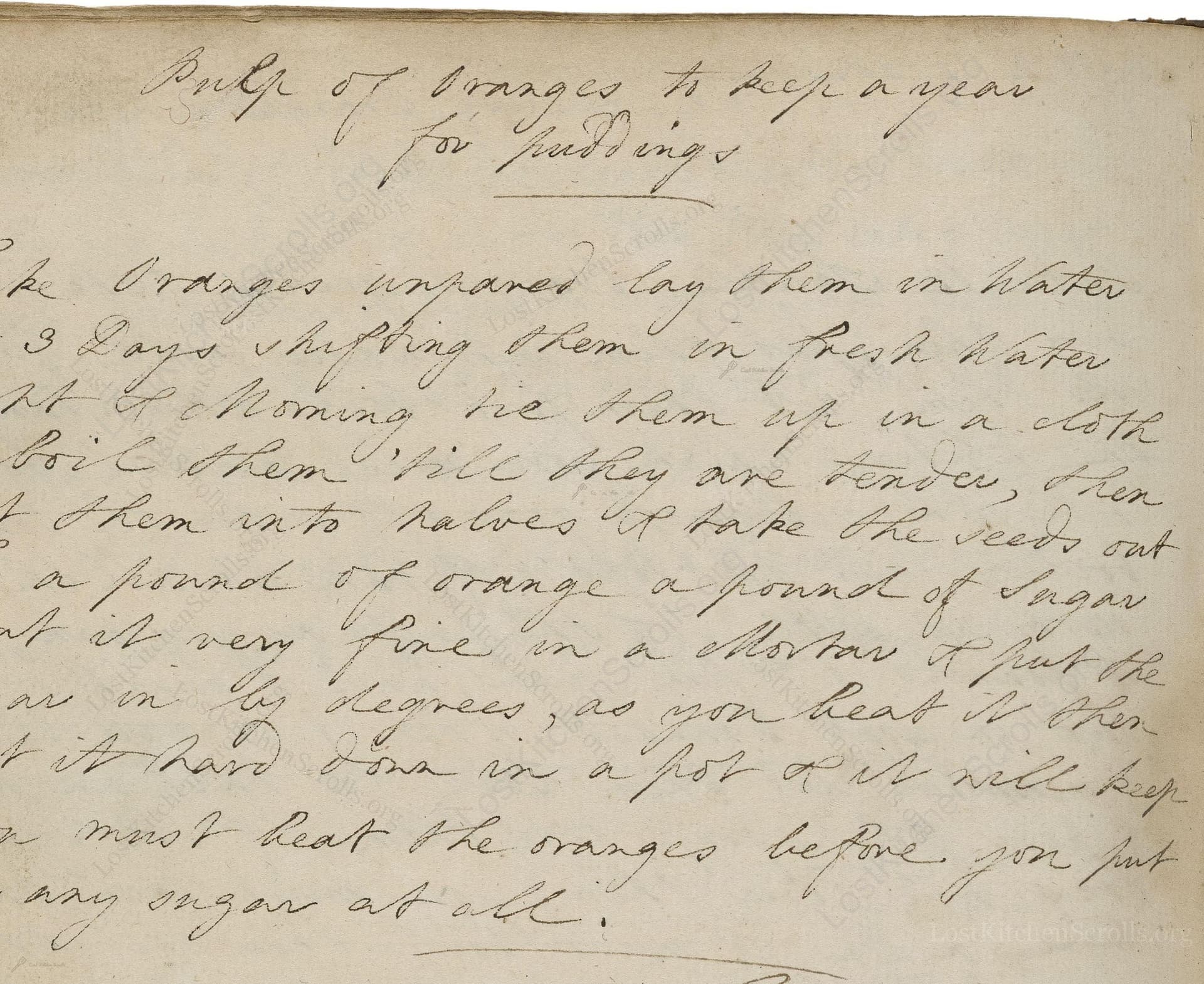Pulp Of Oranges To Keep A Year For Puddings
From the treasured pages of Receipt book of Elizabeth Smith
Written by Elizabeth Smith

Pulp Of Oranges To Keep A Year For Puddings
"Take Oranges unpored lay them in Water 2 or 3 Days shifting them in fresh Water night & Morning - the them up in a cloth & boil them till they are tender, then cut them into halves & take the seeds out To a pound of orange a pound of Sugar beat it very fine in a Mortar & put the sugar in by degrees, as you beat it & then put it hard done in a pot & it will keep. you must heat the oranges before you put in any sugar at all."
Note on the Original Text
The original instructions are written in a brisk, abbreviated style—common in 18th-century domestic manuscripts. Steps are condensed, and the punctuation is minimal, presuming a level of hands-on kitchen knowledge. Words such as 'unpored' likely mean 'unpeeled'. The phrase 'beat it very fine in a Mortar' conveys the importance of texture, and careful order is given to the addition of sugar only after the oranges have been heated. Quantities are measured by weight for both oranges and sugar, a practice that has endured in preserve-making for accuracy.

Title
Receipt book of Elizabeth Smith (1775)
You can also click the book image above to peruse the original tome
Writer
Elizabeth Smith
Era
1775
Publisher
Unknown
Background
Step into the refined kitchens of the late 18th century with Elizabeth Smith, whose culinary wisdom offers a charming taste of Georgian elegance and time-honored recipes to delight any palate.
Kindly made available by
Folger Shakespeare Library
This recipe hails from the late 18th century and was recorded by Elizabeth Smith, a woman living during a time when preserving fruit was both a culinary art and a necessity for the long winter months. Oranges were precious imports in Georgian Britain, and making preserves such as this was a way to extend their fleeting season. The resulting 'pulp of oranges' was intended to be stored and used throughout the year, particularly as a lively flavoring for traditional puddings—think steamed sponges or bread puddings that benefited from citrus brightness. Smith’s manuscript offers modern readers a window into domestic life, resourcefulness, and the creative preservation techniques of the era, long before the convenience of refrigeration.

Back in the day, this recipe would have been crafted with simple but sturdy kitchen implements: a mortar and pestle for pounding and blending the oranges and sugar, a large pot for boiling the fruit, and linen or muslin cloth for drying and wrapping the oranges before boiling. Preserves would be stored in glazed ceramic crocks or glass jars sealed with parchment paper and string or a wax seal.
Prep Time
P2DT20M
Cook Time
1 hr
Servings
8
We've done our best to adapt this historical recipe for modern kitchens, but some details may still need refinement. We warmly welcome feedback from fellow cooks and culinary historians — your insights support the entire community!
Ingredients
- 1 lb (16 oz) whole oranges, unwaxed (substitute: Seville oranges for extra tartness)
- 1 lb (16 oz) white granulated sugar
- Water (for soaking and boiling)
Instructions
- To prepare this vibrant orange preserve, start by selecting whole, unwaxed oranges—about 1 pound (16 ounces) for a small batch.
- Place the oranges, unpeeled, in a bowl of cool water.
- Let them soak for 2–3 days, changing the water every morning and evening.
- This soaking helps mellow the bitterness of the peel and pith.
- After the final soak, pat the oranges dry and wrap them in a clean cloth.
- Boil the wrapped oranges in water until they feel tender when pierced (this can take up to an hour depending on the size of the fruit).
- Once cool enough to handle, cut the oranges in half and remove the seeds.
- Weigh the prepared oranges, then measure an equal weight of white granulated sugar.
- Place the orange pulp (including the peel) into a large mortar and pestle or a sturdy food processor.
- Beat or process the oranges until finely mashed and beginning to release their juices, making sure they are warm before adding any sugar.
- Begin incorporating the sugar gradually, a little at a time, mixing it thoroughly after each addition, until all the sugar is blended in and the mixture is smooth.
- Pack the mixture firmly into a sterilized jar or ceramic crock, and seal tightly.
- Stored in a cool place, this orange preserve can keep for many months and is perfect for puddings or desserts.
Estimated Calories
140 per serving
Cooking Estimates
Allow about 10 minutes to prepare the oranges and soak them over 2-3 days, changing the water twice daily. Boiling the oranges will take around 1 hour. The active cooking time is mostly waiting and boiling, and the recipe makes about one medium jar, with each serving containing sugar and whole oranges for richness.
As noted above, we have made our best effort to translate and adapt this historical recipe for modern kitchens, taking into account ingredients nowadays, cooking techniques, measurements, and so on. However, historical recipes often contain assumptions that require interpretation.
We'd love for anyone to help improve these adaptations. Community contributions are highly welcome. If you have suggestions, corrections, or cooking tips based on your experience with this recipe, please share them below.
Join the Discussion
Rate This Recipe
Dietary Preference
Main Ingredients
Culinary Technique
Occasions

Den Bockfisch In Einer Fleisch Suppen Zu Kochen
This recipe hails from a German manuscript cookbook compiled in 1696, a time whe...

Die Grieß Nudlen Zumachen
This recipe comes from a rather mysterious manuscript cookbook, penned anonymous...

Ein Boudain
This recipe comes from an anonymous German-language manuscript cookbook from 169...

Ein Gesaltzen Citroni
This recipe, dating from 1696, comes from an extensive anonymous German cookbook...
Browse our complete collection of time-honored recipes



